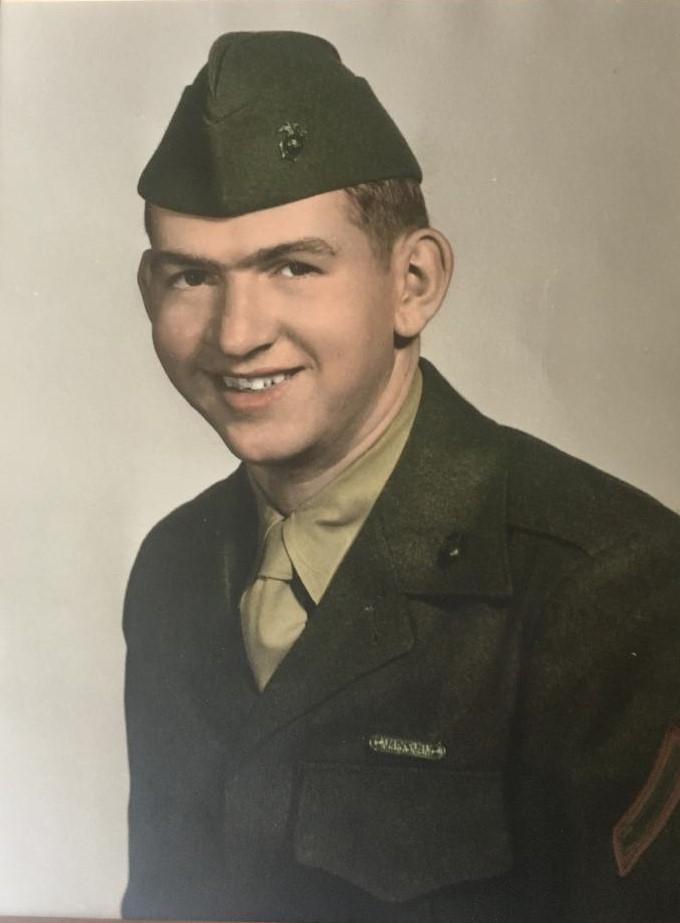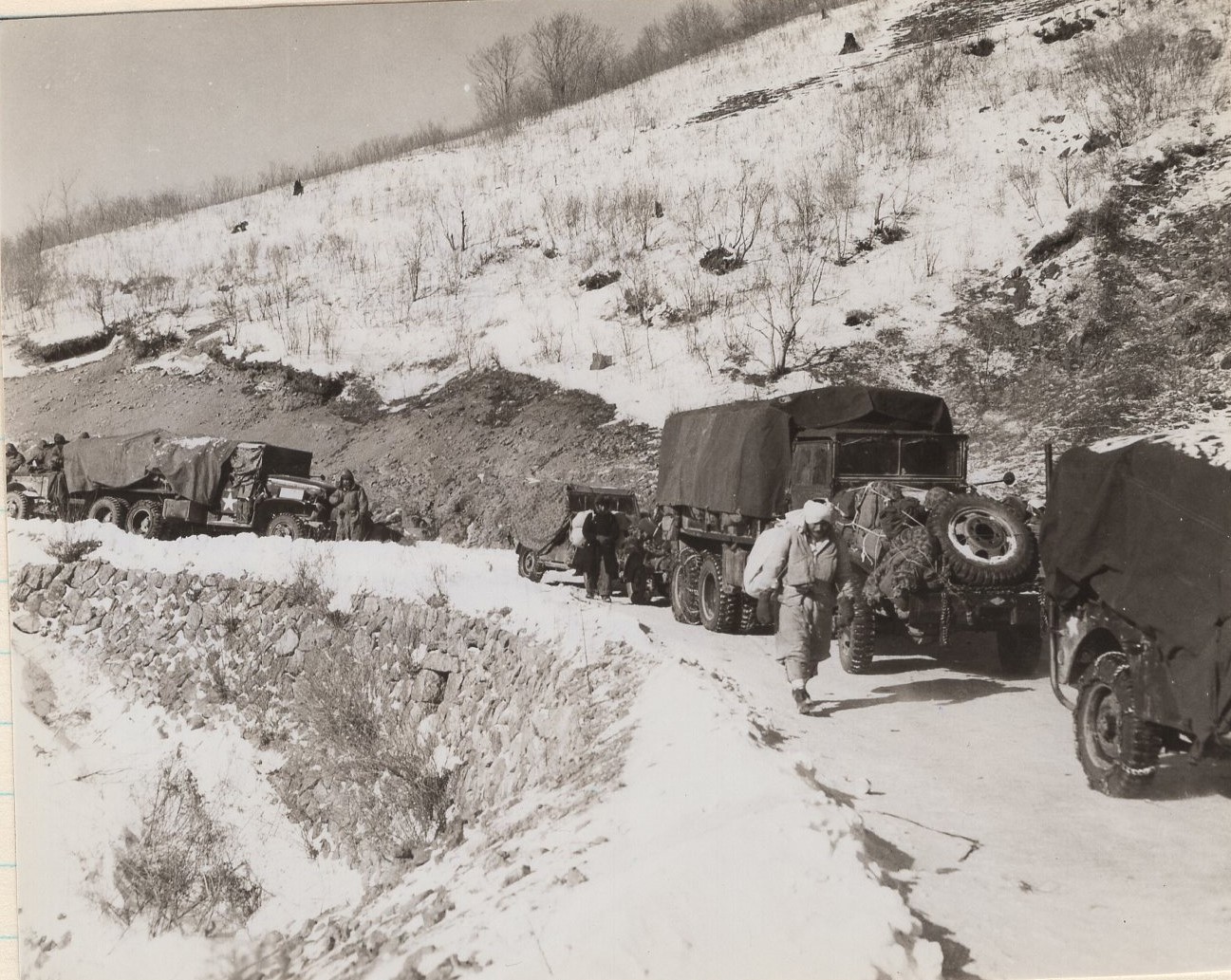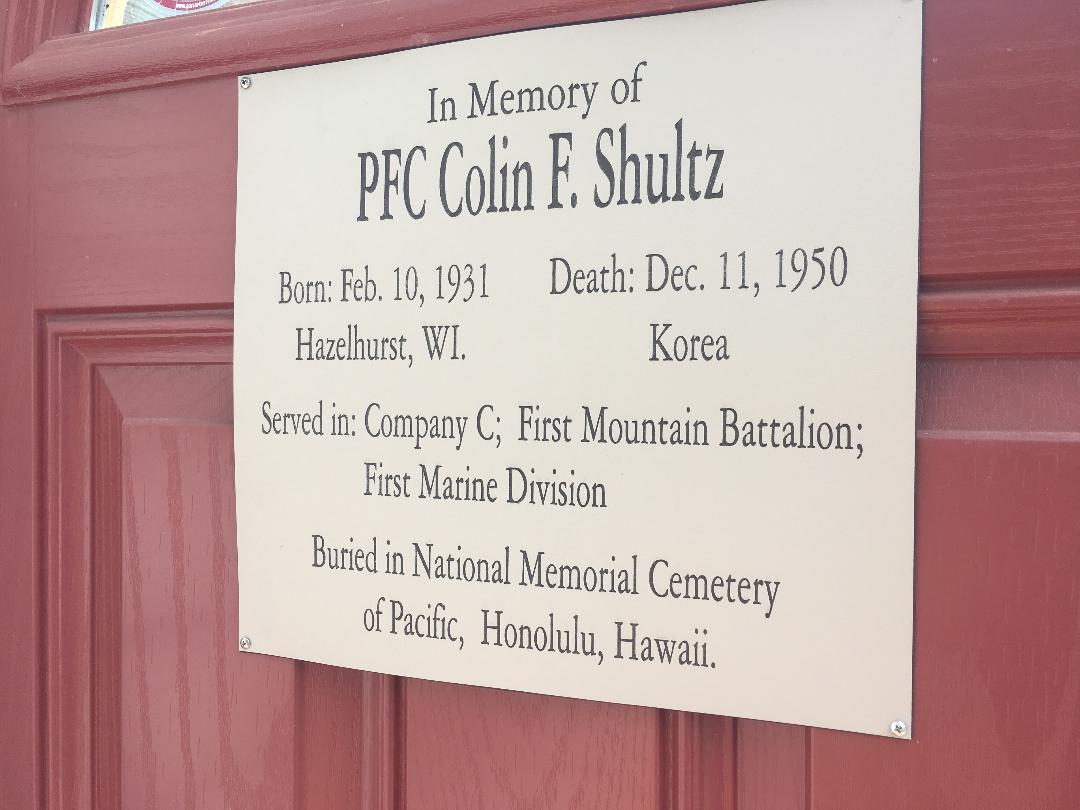Private First Class Colin Forrest Shultz

- Unit: 1st Marine Division, 1st Motorized Transportation Battalion, Company C
- Service Number: 1118287
- Date of Birth: February 10, 1931
- Entered the Military: January 5, 1950
- Date of Death: December 10, 1950
- Hometown: Hazelhurst, Wisconsin
- Place of Death: near Su-dong, Korea
- Award(s): Purple Heart
- Cemetery: Section G, Site 392. National Memorial Cemetery of the Pacific, Honolulu, Hawaii
Ronald Reagan IB High School
2017-2018
Early Life
Colin Shultz was born on February 10, 1931, in Rhinelander, Wisconsin, but grew up 19 miles to the north in the logging village of Hazelhurst. After his parents divorced, Colin lived on his father’s poultry farm in the middle of the Northwoods of Wisconsin. He attended both grammar and Woodruff High School, leaving just months before the end of his senior year. In school he played football, performed in a play, and sang tenor in his church choir.
After leaving high school, Colin worked on his father’s farm, Shultz’s Sprucehaven Farm, for almost a year in which he raised, tended, killed, and packed poultry for market. At some point into the first year of working on the family farm, Colin decided to enlist in the U.S. Marine Corps. In January 1950 he headed to Chicago to enlist.



Military Experience
Training
Shultz enlisted on January 5, 1950 in Chicago, Illinois. By January 8, he arrived at the Marine Corps Recruit Depot on Parris Island, South Carolina. Shultz performed well in boot camp and earned Very Good Service ratings throughout his training period. Shultz then moved to Camp Lejune where he received weapons training on an M-1 rifle and qualified as a marksman. Shultz graduated first in his class in truck driver training on July 14, 1950. Shultz trained in Marine Transportation Systems and was assigned the job of truck driver, eventually being assigned to 1st Marine Division Fleet Marine Force, 1st Mountain Battalion, Company C.
Korea
On August 17, 1950, Shultz boarded the USS General M.C. Meigs and headed to Japan en route to Korea. Shultz disembarked at Incheon, Korea on September 18. Shultz served in the assault and seizure of Inchon from September 15-16, 1950 as well as the liberation of Seoul from September 17 to October 7, 1950.
On October 11 Shultz traveled to Wonsan, Korea and worked on transport in the Wonson-Hungnam-Chosin Campaign that began on October 26, 1950. It became obvious that the Chinese military was involved and the troops were being encircled. Pressure increased as the 1st Marine Division retreated towards the Koto-Ri, Yudam-ni area. The weather was brutal, reaching no more than 40 degrees during the day and getting down to negative 15 degrees at night.
Shultz, along with the rest of Company C, joined the division on December 8. The 1st Marine Division held Koto-Ri since November 28 and joined the efforts to push towards Hungnam. On December 9, Company C led Division Train #1 and followed a truck mounted snow plow as they left Koto-Ri. Unfortunately, a damaged bridge delayed them for several hours.
By December 10, conditions worsened. It was extremely cold and snow reduced visibility to six feet. Eventually, the road became impassable due to deep holes from mortar shells and thick ice from a frozen mountain stream. Officers demanded that rations, tents, and other miscellaneous supplies be thrown into the holes as they were barraged by machine gun and sniper fire.
As the men advanced toward the coast, they encountered an estimated 120,000 Chinese soldiers. Company C was one of the last groups to leave Koto-Ri and continued on towards Hungnam.
Death
On December 11, at 12:30 a.m., Company C was ambushed one half mile outside Su-dong. A mortar hit Shultz’s truck and he and the driver, Private First Class Kenneth Dvorak, were killed. The burning vehicles caused a roadblock. A firefight ensued for several hours before the company was able to move. Dvorak was found dead in his vehicle, and Shultz’s remains were found in a ditch approximately 25 yards in front of the vehicle. The identification was made by the class ring he wore and a red scarf he had been wearing since Toko-Ri.
Due to the attack, Shultz’s body was quickly buried where it lay according to documents. Shultz’s parents were notified of his death on January 2, 1951. It was not until February 20 that his parents were informed his body had been left behind. Shultz was one of 900 killed or missing in the Battle of the Chosin Reservoir. There were an estimated 37,500 Chinese deaths.
Recovery
The men who buried Shultz were assured that others would come along to pick up the bodies, but that was not the case. Shultz’s body was not identified until five years later.
As part of the Korean Armistice Agreement, Operation Glory attempted to repatriate all casualties of the war. Shultz’s body had been captured by the Communist forces and then transferred to UN forces as part of Operation Glory. Shultz was one of six bodies recovered from the site of the Su-dong ambush. Physical details such as dental records, height, race and age were all considered in identifying Shultz’s body in consideration of the fact that he was recovered at the site of the ambush where he had been identified as KIA. His driver, Private First Class Kenneth Dvorak was also identified in the same location.
On July 25, 1955, his parents received notice that Colin Shultz’s remains had been recovered.



Eulogy
On August 1, 1955, Shultz’s parents received a letter from Captain J.A. Weatherspoon informing them of their burial options. Colin’s father, George Shultz, decided after much deliberation to have his son laid to rest at the National Memorial Cemetery of the Pacific. They were unable to make the ceremony. However, his father did have one last request.
When Shultz first enlisted in the military, records show he continuously corrected the spelling of his last name from Schultz to Shultz, without the “c.” After a while, Shultz gave up this practice and the U.S. Marine Corps continued to spell his name with the “c,” even when informing his parents of his death. George Shultz’s final request of the military was to spell his son’s name correctly on his gravestone.
On August 11, 1955 Shultz’s father wrote:
It seems to be the habit of everyone to think he knows better than we do how to spell ‘Shultz.’ Everyone thinks it must be spelled with a C and that is the reason Colin was listed as Schultz in the records. The fact that he was born Shultz and his father, grandfather, great grandfather and I don’t know how many more generations before, seems to make no difference.
This request was granted and further correspondence uses the correct spelling of Shultz.
Shultz’s legacy lives on today. Just south of where he grew up in Hazelhurst, Wisconsin is the small town of Lake Tomahawk. Lake Tomahawk is home to the Colin F. Shultz American Legion Post 318. The legion hosts meat raffles to support veterans and their families and sponsors Memorial Day and Veterans Day ceremonies. The Legion participates in the Fourth of July parade, serves as a social outlet for area veterans, and proudly boasts a pool table in the basement of their legion post. Colin Shultz’s photograph is prominently displayed in the meeting room.


Reflection
Bibliography
1st Marine Division: Korea; General Administrative Files, Sep 1950- Mar 1955, 1st Marines, Unit Reports, 1 Sep 1950- 28 Jan 1951, Record Group 127 (Box 189); National Archives at College Park, College Park, MD.
1st Marine Division: Korea; General Administrative Files, Sep 1950- Mar 1955, 1st Motor Transport Battalion, Unit Reports Sep 1950 – May 1952, Record Group 127 (Box 221); National Archives at College Park, College Park, MD.
Ambushers are Ambushed. Photograph. December 9, 1950. National Archives and Records Administration (127-GK-234J-A5391). Image.
Colin Shultz, Official Military Personnel File, Department of the Navy. U.S. Marine Corps, Record of the U.S. Marine Corps, RG 127, National Archives and Records Administration – St. Louis
Marine Corps Activities in Korea, 1775-1958; Records of the United States Marine Corps, Record Group 127 (Box 8); National Archives at College Park, College Park, MD.
Marine Corps Activities in Korea, 1775-1958; Records of the United States Marine Corps, Record Group 127 (Box 19); National Archives at College Park, College Park, MD.
Marine Corps Activities in Korea, 1775-1958; Records of the United States Marine Corps, Record Group 127 (Box 21); National Archives at College Park, College Park, MD.
Marine Corps Activities in Korea, 1775-1958; Records of the United States Marine Corps, Record Group 127 (Box 25); National Archives at College Park, College Park, MD.
Marine Corps Activities in Korea, 1775-1958; Records of the United States Marine Corps, Record Group 127 (Box 28); National Archives at College Park, College Park, MD.
Marine Corps Activities in Korea, 1775-1958; Records of the United States Marine Corps, Record Group 127 (Box 29); National Archives at College Park, College Park, MD.
Mustacci, Chris. Dusk in the Northwoods of Wisconsin. 2018. Personal Collection.
Nehls, Heidi Swanson. Early Fall in Northern Wisconsin. Photograph. 2018. Personal Collection.
Schwartz, Anna. Northern Wisconsin Backwaters. Photograph. 2018. Personal Collection.
South of Koto-Ri. Photograph. December 10, 1950. National Archives and Records Administration (127-GK-234J-A5405). Image.

